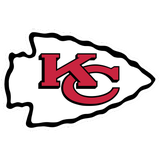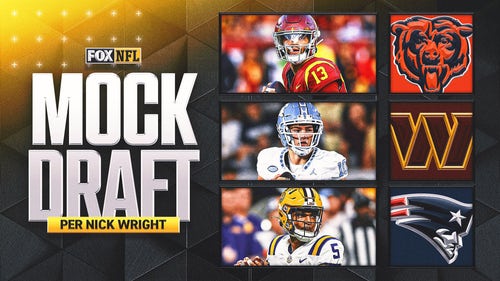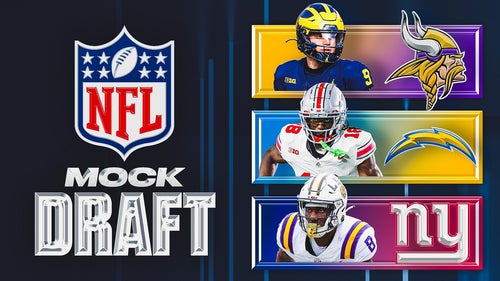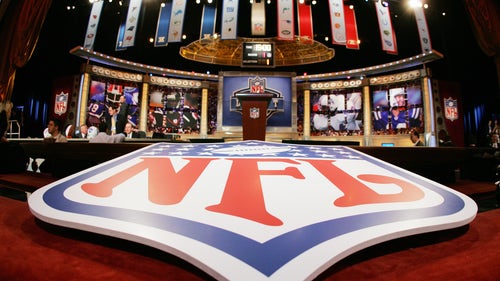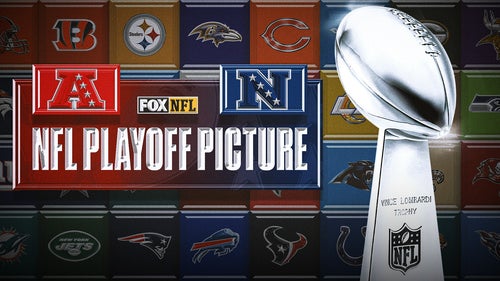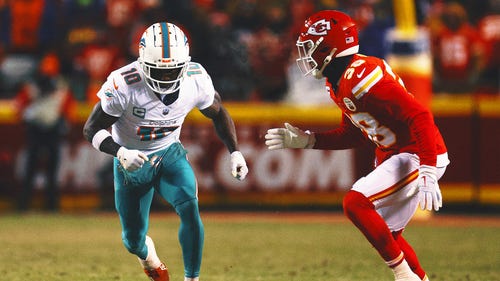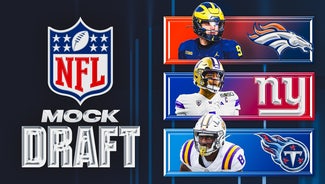
The Divisional Round's Dangerous Dozen
12. Antonio Brown, WR, Steelers
At the core of Pittsburgh’s Week 4 blowout win over the Chiefs were deep route combinations that attacked Kansas City’s single-high safety. Eric Berry and Ron Parker both made mental mistakes here. It’s a less threatening Steelers receiving corps this time around. Markus Wheaton is out, and Sammie Coates remains at the back of the pecking order after a midseason hand injury (Mike Tomlin can be reluctant to cycle guys back into the rotation late in the year). Expect to see Brown align on the left side (away from Marcus Peters) and threaten Kansas City’s secondary with deep posts, digs and long crossers. He must also be accounted for on receiver screens, which, as the Dolphins learned last Sunday, can quickly go house.
11. Grady Jarrett, DT, Falcons
Seattle’s offensive line was very solid against Detroit, particularly inside with young guards Mark Glowinski and Germain Ifedi plus center Justin Britt. They overachieved against a bigger, athletically imposing Lions defensive front. But Detroit’s front has no one like Grady Jarrett. That’s right, Grady Jarrett—Atlanta’s little-known 2015 fifth-rounder is one of the most destructive forces that Seattle’s O-line will have faced this season. Jarrett has outstanding quickness, the raw strength to shed blocks and the nimbleness to change directions in confined areas. He’ll be near the league lead in tackles-for-loss once he learns to finish plays in the backfield. Just getting in the backfield can still wreck a zone ground game like Seattle’s.
10. Cole Beasley, slot receiver, Cowboys
If Packers defensive coordinator Dom Capers sticks to his recent modus operandi, he’ll play man coverage and have his safeties double-team Dez Bryant and Jason Witten. That leaves single coverage everywhere else. Beasley becomes the concern. Few receivers set up and execute their breaks with more acuity and quickness. Micah Hyde has been beyond stellar transitioning back to the slot this season, but stylistically, Beasley is a tough matchup.
* * *
* * *
9. Marcus Peters, CB, Chiefs
Ben Roethlisberger attacked the second-year corner deep in that Sunday night matchup earlier this season, but that was with Sammie Coates at full throttle. It’s a weaker receiving corps now, with Cobi Hamilton the predominant outside threat and Darrius Heyward-Bey the designated deep artist. Peters has a tendency to bite on double moves, but he also has a tendency to successfully jump your single moves. The nature of Pittsburgh’s offense and Kansas City’s defense could make him hard to avoid. Either Antonio Brown will align across from Peters, where Roethlisberger will work his best against K.C.’s best, or Brown will line up on the other side, where he’s often isolated. That would leave Pittsburgh’s primary route combinations on Peters’ side. The Chiefs are regarded as a man-to-man defense, but really they play more of a matchup Cover 3. Often this shakes out just like man-to-man, but there can be help-coverage wrinkles that allow Peters (and all players) to pass off assignments and go defend elsewhere. Peters has made several big plays doing this, and Roethlisberger a few times lately has gotten caught with throwing into coverage.
8. Julian Edelman, slot receiver, Patriots
Houston’s outside corners, Johnathan Joseph and A.J. Bouye, have been sensational. Inside is where you want to attack this defense. Slot defender Kareem Jackson missed the second half of last week’s game against Oakland. Robert Nelson was decent in his stead, but he’s been prone to penalties, particularly against deeper routes. Edelman is most noted for his work underneath, but since Rob Gronkowski went out, he’s subtly become a more vertical weapon.
Whoever defends the slot for Houston faces a challenge. This, of course, is assuming the Texans are in a matchup coverage. There’s still the issue of what happens when it’s traditional zone coverage, where Edelman can work inside against linebackers. Benardrick McKinney and Brian Cushing are athletic, but not athletic enough to hang with the NFL’s best slot receiver.
7. Michael Bennett, DL, Seahawks
Atlanta’s zone rushing attack comes in white-hot. Bennett, with his startling initial quickness (both up the field and laterally) and keen awareness can be as disruptive as they come here. Surrounded by smart, fast players, he has the luxury of taking chances and, at times, outright eschewing his gap assignment to go make a play. He’ll attack at angles foreign to most offensive linemen. Bennett holds a big key; if Atlanta’s ground game is compromised, then potentially so is their bootleg and play-action game. And now we’re talking about a different offense than the one that averaged 36.7 points over the season’s final six weeks.
6. Travis Frederick, C, Cowboys
When Dallas’s ground game is rolling, it’s when the fourth-year center is controlling nose tackles with reach-and-seal blocks off the snap. Frederick isn’t Dallas’s most athletic lineman (that’d be left tackle Tyron Smith) or most dominant (this year that’s right guard Zack Martin), but based on the construction of this outside zone ground game, he’s the most important.
The Packers don’t like to crowd the box in run defense. Instead they rely on strongmen Mike Daniels and Letroy Guion to win fistfights, trusting that the athletes around these two can clean up from there. One thing defensive coordinator Dom Capers could do is have Guion align not over Frederick, as the biggest defensive tackle would in most schemes, but over one of Dallas’s guards. (Mike Daniels would align over the other guard, forming what’s called an “even front.”) The geometry of this alignment would complicate Frederick’s ability to reach the defensive tackle’s outside shoulder, which severely limits your outside zone game. In fact, the Cowboys could be compelled to go with more inside zone. That’d mean double-team blocks up the middle. This talented O-line also does that as well as any in football, though it’s not their forte.
5. Julio Jones, WR, Falcons
Richard Sherman traveled with Jones in the Week 6 Falcons-Seahawks matchup. That could be the case again. Sherman is a very specific type of player. He’s borderline unbeatable along the defensive left boundary. He’s stellar, even sensational, along the right boundary. He’s less stingy in the slot. And where teams have success against him are on in-breaking patterns; Sherman doesn’t always display the necessary hip quickness here. In-breaking patterns, including from the slot, are what Jones does better than anyone.
4. Russell Wilson, QB, Seahawks
His contributions to the ground game are significant. Even when he’s just handing it off, the Seahawks wisely structure many of their plays in a way that forces a backside defender to account for the QB. When that backside defender starts to stray from this responsibility, Wilson becomes a rushing weapon himself. Then there’s the issue of Wilson’s legs in the passing game. Atlanta’s four-man rush is predicated on stunts that send NFL sack-leader Vic Beasley on wide-looping rushes inside. Do they still employ these against a mobile QB who is so dangerous when getting outside the pocket? If the Falcons choose to rush Beasley straight up the field, where he’s in position to contain, then they’re relying on their straight four-man rush, which was extremely inconsistent throughout the year. Atlanta’s back seven isn’t good enough to survive late into the down when Wilson goes into sandlot mode. It’s vital the Falcons get bodies near the quarterback. They just need to approach this with caution.
3. Jadeveon Clowney, DE, Texans
He’s the only guy who can ruin the game for New England. (Here’s why.)
• CLOWNEY IS HOUSTON’S ONLY HOPE: How the budding star can rattle Tom Brady.
2. Le’Veon Bell, RB, Steelers
You’ve probably heard (eight or nine thousand times) about Bell’s patience as a runner. He can play that way because he has the sudden elusiveness and acceleration to find a faster gear in the blink of an eye. Indeed, Bell right now is as hot running the ball as Aaron Rodgers is throwing it. And he’s going up against a Chiefs run defense that is difficult to reconcile. The Chiefs have a lot of strong individual pieces up front. Dontari Poe is as athletic as any 346-pounder you’ll see. Comparable to him is rookie Chris Jones, who weighs 310, and has great strength plus even better movement skills. Second-year man Rakeem Nunez-Roches has been one of the more pleasant surprises of this NFL season, filling in for the injured Jaye Howard (himself one of the game’s more underappreciated run defenders). In Derrick Johnson the Chiefs had a smart linebacker who was swift in traffic. Since Johnson ruptured his Achilles on December 8, Ramik Wilson has assumed his duties. After an up-and-down first few outings, Wilson flashed against the run in Week 17 at San Diego. It’s plain to see: There are plenty of good run-defending pieces in place, especially if you factor Eric Berry when he comes into the box. And yet this run defense ranked 26th. Too often it looks like a collection of talented individuals, rather than one staunch unit. Bell’s not the runner a unit like that wants to face.
1. Aaron Rodgers, QB, Packers
How do you defend the man who, right now from a physical standpoint, is playing the quarterback position better than it’s ever been played? When the Cowboys faced Rodgers in October, they often spied him with a linebacker—that week it was Justin Durant—and played man coverage against his receivers. This was at a time when Rodgers was uncharacteristically struggling with accuracy.
Man coverage can still be a viable plan, especially if Jordy Nelson is out. (Remember how the Packers struggled against man-to-man without Nelson last year?) But the concern, especially if you sacrifice a defender to spy Rodgers, is what happens when the play is extended? Right now, pass rushers simply aren’t getting through Green Bay’s offensive line. This was the Giants’ biggest problem last Sunday. Dallas’s four-man rush (or three-man rush, depending if and how a QB spy is deployed) has more juice than New York’s, but not by much.
Question or comment? Email us at talkback@themmqb.com.
